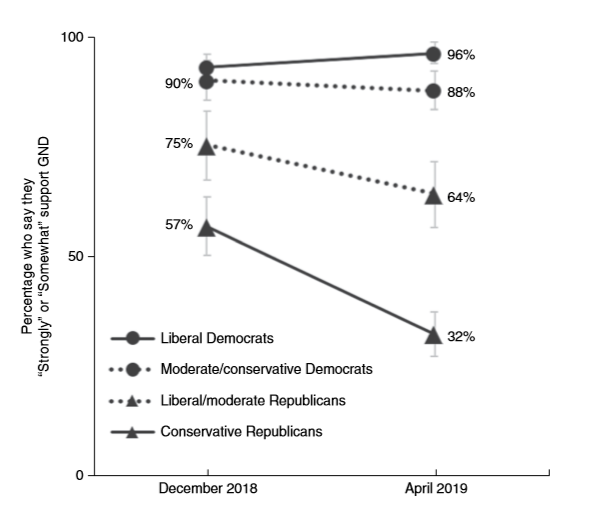

气候危机与美国的“社会主义”思潮
联合国一份报告指出[1],如果气候问题持续恶化,到2040年,地球很可能就会提前经历食物短缺,致命的热浪和珊瑚礁的大规模死亡。因此,该报告呼吁对全球能源体系和经济发展方式进行大规模的变革。
面对上述呼吁,在2019年举行的第116届美国国会会议上,美国历史上最年轻女众议员、民主党人亚历山德里娅·奥卡西奥-科尔特斯(Alexandria Ocasio-Cortez)和民主党参议员埃德·马基(Ed Markey) 共同提出了一份14页的绿色新政决议[2]。这份决议在环境问题上明确提出了促进美国能源结构从依赖化石能源向100%依靠可再生能源的转变,争取实现净零排放目标,促进投资电动汽车和高铁系统等目标,并再次强调了奥巴马政府时期提出的将碳排放计算入社会成本的计算,进而影响政策制定和执行的提议[3]。
这份决议案似乎并没有仅仅将目光放在环保问题上,而是希望以环保问题为突破口,以十年时间为期,进一步推行更多促进社会改革的政策。除了上述环保问题,这份决议还呼吁提高全民医疗保障 、全民高质量教育、防止垄断、提高最低工资和退休保障以及增加带薪休假等社会福利方面的政策。这份决议还重点呼吁大力度推动环保基础设施的建设。
这种加大公共支出发展社会福利的政策主张随即在美国社会引发了争议。许多同样持有进步观点的学者对这份决议所提出的时间表的可行性表示质疑。奥巴马政府前顾问、哈佛大学环境政策教授约翰·霍尔德(John P. Holdren)表示,绿色新政的施行是迫在眉睫的,但是其在2030年左右实现这一目标的时间表并不可行。从技术角度看,如果将这份政策坚持下去,美国有希望到2045年或2050年能做到[4]。而激进的左翼观点持有者甚至认为,这份决议是在“洗刷和掩饰”资本主义本身的黑暗面。
不出所料,右翼观点持有者旗帜鲜明地反对这份决议,认为其将带来庞大的政府开支。2019年2月,中右翼的美国行动论坛(American Action Forum)对该计划在2020-2029年间增加的政府支出做了估算,十年总成本为51-93万亿美元,即每年5.1-9.3万美元;建设净零排放的交通运输系统约需0.13-0.27万亿美元/年;为全民提供工作的成本约为0.68-4.46万亿美元/年;全民医疗保障服务3.6万亿美元/年[5]。华尔街公开表示支持“绿色新政”,但前提必须是政府保证能够持续地落实推进实现上述目标的相关政策,否则华尔街不会为这份决议投入海量投资[6]。
政治极化:社会的进步与割裂

来源:Gustafson, Abel, Seth A. Rosenthal, Matthew T. Ballew, Matthew H. Goldberg, Parrish Bergquist, John E. Kotcher, Edward W. Maibach, and Anthony Leiserowitz. “The Development of Partisan Polarization over the Green New Deal.” Fig-2, Nature Climate Change 9, no. 12 (2019): 940–44. 同脚注8
注释:
[1] Global Warming of 1.5 ºC. Accessed June 7, 2020.https://www.ipcc.ch/sr15/.
[2] Recognizing the duty of the Federal Government to create aGreen New Deal. § (n.d.).https://ocasio-cortez.house.gov/sites/ocasio-cortez.house.gov/files/Resolution%20on%20a%20Green%20New%20Deal.pdf
[3] “Technical Support Document: Technical Update of the SocialCost of Carbon for Regulatory Impact Analysis Under Executive Order No. 12866.”Federal Register, November 26, 2013.https://www.federalregister.gov/documents/2013/11/26/2013-28242/technical-support-document-technical-update-of-the-social-cost-of-carbon-for-regulatory-impact.
[4] Friedman, Lisa, and Trip Gabriel. “A Green New Deal IsTechnologically Possible. Its Political Prospects Are Another Question.” TheNew York Times. The New York Times, February 21, 2019.https://www.nytimes.com/2019/02/21/us/politics/green-new-deal.html.
[5] Holtz-Eakin, Dan Bosch, Ben Gitis, Dan Goldbeckr, et al. “TheGreen New Deal: Scope, Scale, and Implications.” AAF, February 25, 2019. https://www.americanactionforum.org/research/the-green-new-deal-scope-scale-and-implications/.
[6] Bloomberg.com. Bloomberg. Accessed June 7, 2020.https://www.bloomberg.com/news/articles/2019-02-14/wall-street-is-more-than-willing-to-fund-the-green-new-deal.
[7] “Political Polarization on the Green New Deal IncreasedDramatically.” Yale Program on Climate Change Communication. Accessed June 7,2020.https://climatecommunication.yale.edu/publications/how-political-polarization-increased-on-the-green-new-deal/.
[8] Gustafson, Abel, Seth A. Rosenthal, Matthew T. Ballew,Matthew H. Goldberg, Parrish Bergquist, John E. Kotcher, Edward W. Maibach, andAnthony Leiserowitz. “The Development of Partisan Polarization over the GreenNew Deal.” Nature Climate Change 9, no. 12 (2019): 940–44.https://doi.org/10.1038/s41558-019-0621-7.
[9] “Roll Call Vote 116th Congress - 1st Session.” U.S. Senate:U.S. Senate Roll Call Votes 116th Congress - 1st Session, January 16, 2020. https://www.senate.gov/legislative/LIS/roll_call_lists/roll_call_vote_cfm.cfm?congress=116&session=1&vote=00052#position.
作者:梅鑫洋
校对:袁雅婷、赵昂、林佳乔
